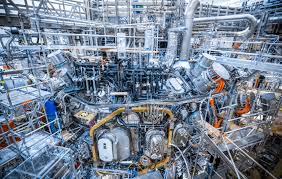
Breaking News
 Christmas Truce of 1914, World War I - For Sharing, For Peace
Christmas Truce of 1914, World War I - For Sharing, For Peace
 The Roots of Collectivist Thinking
The Roots of Collectivist Thinking
 What Would Happen if a Major Bank Collapsed Tomorrow?
What Would Happen if a Major Bank Collapsed Tomorrow?
Top Tech News
 EngineAI T800: Born to Disrupt! #EngineAI #robotics #newtechnology #newproduct
EngineAI T800: Born to Disrupt! #EngineAI #robotics #newtechnology #newproduct
 This Silicon Anode Breakthrough Could Mark A Turning Point For EV Batteries [Update]
This Silicon Anode Breakthrough Could Mark A Turning Point For EV Batteries [Update]
 Travel gadget promises to dry and iron your clothes – totally hands-free
Travel gadget promises to dry and iron your clothes – totally hands-free
 Perfect Aircrete, Kitchen Ingredients.
Perfect Aircrete, Kitchen Ingredients.
 Futuristic pixel-raising display lets you feel what's onscreen
Futuristic pixel-raising display lets you feel what's onscreen
 Cutting-Edge Facility Generates Pure Water and Hydrogen Fuel from Seawater for Mere Pennies
Cutting-Edge Facility Generates Pure Water and Hydrogen Fuel from Seawater for Mere Pennies
 This tiny dev board is packed with features for ambitious makers
This tiny dev board is packed with features for ambitious makers
 Scientists Discover Gel to Regrow Tooth Enamel
Scientists Discover Gel to Regrow Tooth Enamel
 Vitamin C and Dandelion Root Killing Cancer Cells -- as Former CDC Director Calls for COVID-19...
Vitamin C and Dandelion Root Killing Cancer Cells -- as Former CDC Director Calls for COVID-19...
 Galactic Brain: US firm plans space-based data centers, power grid to challenge China
Galactic Brain: US firm plans space-based data centers, power grid to challenge China
Scientists reach pivotal breakthrough in quest for limitless energy:

Proxima Fusion has maintained its position as a global leader in the race to commercial fusion.
A German startup, Proxima Fusion, has developed a plan to generate limitless energy in a working fusion power plant.
The plan is a significant development because nuclear fusion creates abundant energy while releasing zero carbon pollution and only small amounts of radiation. In contrast, nuclear fission creates dangerous radioactive waste.
As TechCrunch reported, Proxima Fusion was founded two years ago. The company published its plan in Fusion Engineering and Design to publicly share its findings with the world and promote open-source science.
Proxima Fusion is on a mission to bring safe, clean, limitless energy to the grid. The company is at the forefront of fusion research and believes stellarators are the power plants of the future.
A stellarator is a magnetic confinement fusion device and machine that keeps plasma in a doughnut-like shape. Scientists can use the strong magnetic fields of stellarators to control plasma particles and create fusion with greater flexibility than tokamaks, another technology scientists use.
Proxima Fusion's Stellaris design demonstrates how a fusion power plant could operate continuously and reliably without issues such as tokamaks' instability and disruptions. The startup's design only uses external magnets to make the process more stable and continuous.
"We summarize a comprehensive reactor study, ranging from optimization of the plasma confinement region to first wall cooling, divertor considerations, blanket design, magnet quench safety, support structures, and remote maintenance solutions," the scientists wrote.
Francesco Sciortino, co-founder and CEO of Proxima Fusion, said: "Our American friends can see it. Our Chinese friends can see it. Our claim is that we can execute on this faster than anyone else, and we do that by creating a framework for integrated physics, engineering, and economics. So we're not a science project anymore."
Fusion power plants have the potential to bring clean, reliable energy to the grid, creating a more sustainable future and promoting a healthier planet and people. Meanwhile, other companies, including Commonwealth Fusion Systems, Helical Fusion, Zap Energy, and Marathon Fusion, are also working to advance the field of fusion energy.
The Proxima Fusion scientists completed their Stellaris design a year quicker than predicted. They obtained millions of dollars from the German government, the European Union, and venture capitalists to fund their research.

 The State's Last Stand
The State's Last Stand


